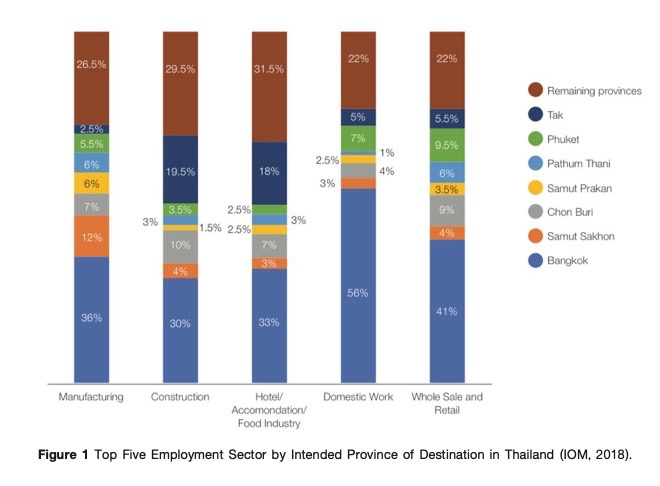Relationships Between Thai Language Proficiency and Livelihoods of Myanmar Urban Migrant Workers
Main Article Content
Abstract
For decades, Thailand has been the recipient of foreign migrant workers from neighbouring countries, with the majority of these workers being from Myanmar. Myanmar migrant workers are employed in various job sectors such as agriculture, manufacturing factories, and service sectors. They usually earn an adequate wage, which provides a living that is not possible in their home country. However, their income and working conditions largely depend on several factors, including host language fluency. This paper is one of the first papers about migrants and Thai language fluency using Thailand as a case study. In this research study, open-ended questions were used to conduct semi-structured interviews with Myanmar urban migrant workers from different work sectors as well as a representative from a language academy in Bangkok. The results of this study show that Thai language proficiency affects the income of the Myanmar migrants as well as their career opportunities. The policy implications suggested by this paper include implementation of Thai language training for urban migrants by the Bangkok Metropolitan Administration and its non-formal education department.
Downloads
Article Details

This work is licensed under a Creative Commons Attribution-NonCommercial-NoDerivatives 4.0 International License.
All material is licensed under the terms of the Creative Commons Attribution 4.0 International (CC-BY-NC-ND 4.0) License, unless otherwise stated. As such, authors are free to share, copy, and redistribute the material in any medium or format. The authors must give appropriate credit, provide a link to the license, and indicate if changes were made. The authors may do so in any reasonable manner, but not in any way that suggests the licensor endorses you or your use. The authors may not use the material for commercial purposes. If the authors remix, transform, or build upon the material, they may not distribute the modified material, unless permission is obtained from JARS. Final, accepted versions of the paper may be posted on third party repositories, provided appropriate acknowledgement to the original source is clearly noted.
References
Boyd, M., & Cao, X. (2009). Immigrant language proficiency, earnings, and language policies. Canadian Studies in Population, 36(1-2), 63-86. https://doi.org/10.25336/P6NP62
Braun, V., & Clarke, V. (2006). Using thematic analysis in psychology. Qualitative Research in Psychology, 3(2), 77-101. https://doi.org/10.1191/1478088706qp063oa
Budría, S., & Swedberg, P. (2012). The impact of language proficiency on immigrants’ earnings in Spain (IZA Discussion Paper, No. 6957). https://dx.doi.org/10.2139/ssrn.2170645
Chantavanich, S., & Vungsiriphisal, P. (2012). Myanmar migrants to Thailand: Economic analysis and implications to Myanmar development. In H. Lim, & Y. Yamada (Eds.), Economic reforms in Myanmar: Pathways and prospects (pp. 213-280). https://www.ide.go.jp/library/English/Publish/Reports/Brc/pdf/10_06.pdf
Chiswick, B. R. (1998). Hebrew language usage: Determinants and effects on earnings among immigrants in Israel. Journal of Population Economics, 11(2), 253-271. https://doi.org/10.1007/s001480050068
Chiswick, B. R., & Wang, Z. (2016). Social contacts, Dutch language proficiency and immigrant economic performance in the netherlands: A longitudinal study (IZA Discussion Paper, No. 9760). https://dx.doi.org/10.2139/ssrn.2742548
Dustmann, C. (1993). Earnings adjustment of temporary migrants. Journal of Population Economics, 6(2), 153-168. https://doi.org/10.1111/1467-9442.00158
Dustmann, C. (1999). Temporary migration, human capital, and language fluency of migrants. The Scandinavian Journal of Economics, 101(2), 297-314. https://doi.org/10.1111/1467-9442.00158
Grenier, G. (1984). The effects of language characteristics on the wages of Hispanic-American males. Journal of Human Resources, 19(1), 35-52. https://doi.org/10.2307/145415
Harkins, B., Lindgren, D., & Suravoranon, T. (2017). Risks and rewards: Outcomes of labour migration in South-East Asia. ILO Regional Office for Asia and the Pacific. http://ilo.org/asia/publications/WCMS_613815/lang--en/index.htm
Huguet, J. W., & Punpuing, S. (2005). International migration in Thailand. International Organization for Migration, Regional Office Bangkok, Thailand. https://www.burmalibrary.org/sites/burmalibrary.org/files/obl/docs22/iom_2005_international_migration_in_thailand_15.pdf
International Organization for Migration (IOM). (2018). Flow monitoring surveys: Insights into the profiles and vulnerabilities of Myanmar migrants to Thailand. https://migration.iom.int/sites/default/files/public/reports/IOM%20-%20DTM%20Thailand%20FM%20Survey%20Report.pdf
International Organization for Migration (IOM). (2019a). Thailand migration report 2019. https://thailand.iom.int/thailand-migration-report-2019-0
International Organization for Migration (IOM). (2019b). Flow monitoring surveys: Insights into the profiles and vulnerabilities of Myanmar migrants to Thailand: Round three. https://migration.iom.int/reports/thailand-%E2%80%94-flow-monitoring-surveys-insights-profiles-and-vulnerabilities-myanmar-migrants-1
Pangsapa, P. (2015). When battlefields become marketplaces: Migrant workers and the role of civil society and NGO activism in Thailand. International Migration, 53(3), 124-149. https://doi.org/10.1111/j.1468-2435.2009.00559.
Pearson, E., Punpuing, S., Jampaklay, A., Kittisuksathit, S., & Prohmmo, A. (2006). The Mekong challenge: Underpaid, overworked and overlooked: The realities of young migrant workers in Thailand. International Programme on the Elimination of Child Labor, International Labour Organization. http://www.oit.org/wcmsp5/groups/public/---asia/---ro-bangkok/documents/publication/wcms_bk_pb_67_en.pdf
Shields, M. A., & Wheatley Price, S. (2001). Language fluency and immigrant employment prospects: Evidence from Britain’s ethnic minorities. Applied Economics Letters, 8(11), 741-745. https://doi.org/10.1080/13504850010038678
Tainer, E. (1988). English language proficiency and the determination of earnings among foreign-born men. Journal of Human Resources, 23(1), 108-122. https://doi.org/10.2307/145847
Turnell, S., Vicary, A., & Bradford, W. (2008). Migrant-worker remittances and Burma: An economic analysis of survey results. In M. Skidmore, & T. Wilson (Eds.), Dictatorship, disorder and decline in Myanmar (pp.63-86). ANU E Press.


